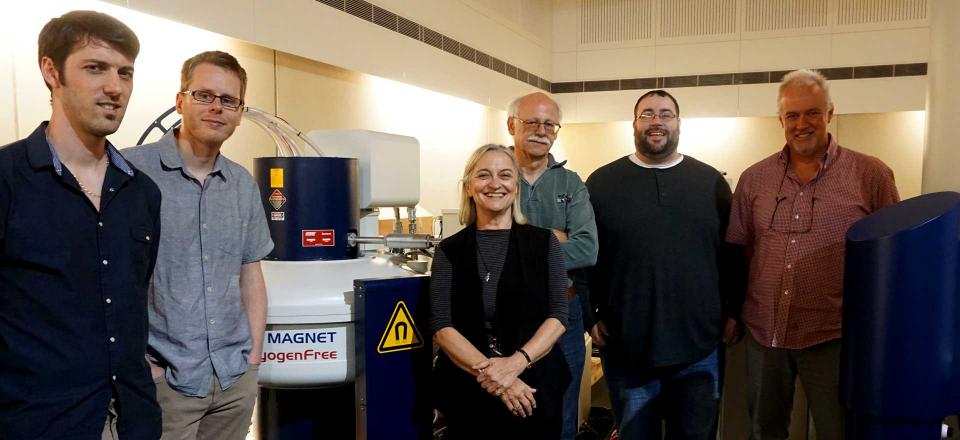Making molecules dance by DNP and celebrating the arrival of the ‘gyrotron’

14 December 2016
From frog-skin antimicrobial peptides and amyloid protein in Alzheimer’s disease to carbon fibre-polymer composite materials used in aerospace engineering, the newly installed DNP-NMR spectrometer will make it possible to obtain highly accurate structural information on small molecules and proteins, in a much shorter time periods. It is already in high demand.
On the 14 December 2016 Professor Frances Separovic, Bio21 and School of Chemistry, Dr Luke O’Dell, Deakin University, Dr Marc-Antoine Sani and Dr David Keizer, Bio21 and a team from Bruker were all gathered in the Magnetic Resonance facility to celebrate the installation of the Dynamic Polarisation Nuclear Magnetic Resonance spectrometer (DNP-NMR) at the Bio21 Molecular Science and Biotechnology Institute.
The three-person team, as well as a local engineer, from Bruker had travelled from across the globe – Switzerland, France and the US – to install the DNP-NMR at the Bio21 Molecular Science and Biotechnology Institute, making it the 28th to be installed in the world and the first DNP-NMR to be installed in the Southern Hemisphere.
The University of Melbourne, (Luke O’Dell, Maria Forsyth) Deakin University and (Oliver Jones) RMIT have all contributed to the 2016 ARC LIEF grant for the acquisition of the DNP-NMR, which includes a $1.8M gyrotron and low temperature cooling unit and a $720k nuclear magnetic resonance spectrometer.
The instruments are newly installed in Australia’s largest magnetic resonance facility at the Bio21 Molecular Science and Biotechnology Institute, which houses nine NMR spectrometers. The DNP-NMR is available and accessible to external users.
Nuclear magnetic resonance (NMR) spectrometers are used by researchers to identify individual atoms in materials by their unique atomic and molecular signatures. However, these signals are inherently weak and often hidden beneath random background ‘noise’ of other signals. In order to read the signals of the molecule of interest and interpret the data, it is necessary to acquire many scans which is time-consuming and a potentially costly exercise.
By transferring magnetisation from negatively charged atomic particles (electrons) to the nucleus of interest using a gyrotron, dynamic nuclear polarisation (DNP) significantly enhances the signal received from the NMR spectrometer, separating it out from the background noise and making it clearly visible.
“Using DNP the signal from an amino acid was enhanced 250 times, thereby creating 625,000 saving in time. You save so much time in getting a signal with the DNP-NMR and it also allows you to look at molecules in situ,” explains Separovic. “We will be looking at the antimicrobial peptide ‘maculatin’ - which was identified in the Australian Green Tree Frog - in bacteria. We’ll study how it enters the cell, where it goes and what it does to the bacteria,” explains Professor Separovic, lead CI on the ARC LIEF application.
Separovic’s team uses NMR to study and develop ant-microbial peptides as well as the amyloid protein in Alzheimer’s disease. “The DNP-NMR will help us to obtain molecular structures of proteins in their native state; as they occur in cells and membranes,” she says.
Luke O’Dell, lecturer in materials science and head of the NMR laboratory at Deakin University will be using the DNP-NMR to study materials developed for use in aerospace engineering: “We study carbon fibres that are combined with polymers in composite materials that are extremely strong and light. Our team at Deakin University will use the DNP-NMR to study the surface of these materials,” he says.
By Florienne Loder

